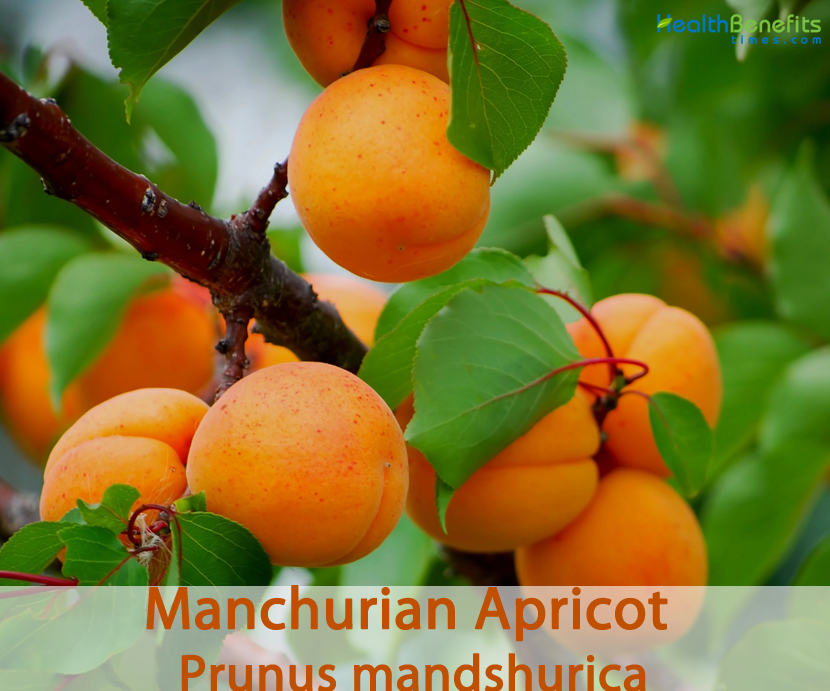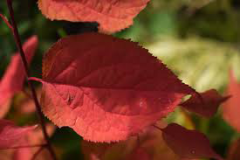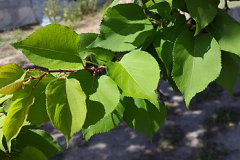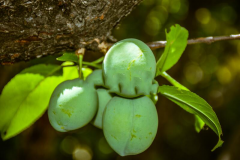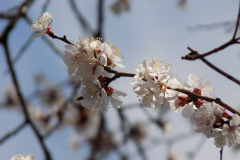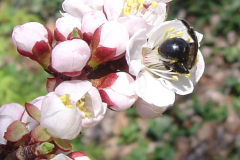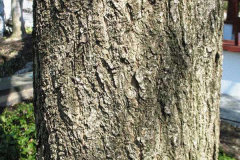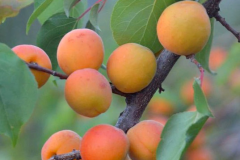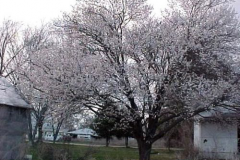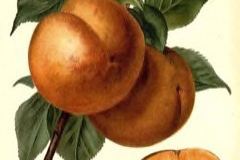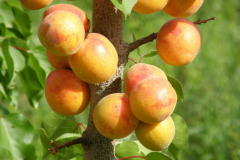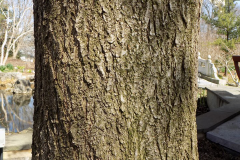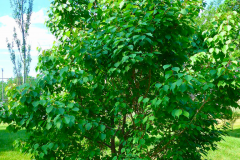| Manchurian Apricot Quick Facts | |
|---|---|
| Name: | Manchurian Apricot |
| Scientific Name: | Prunus mandshurica |
| Origin | Northeast China, Korea, and Manchuria |
| Colors | Initially green turning to orange yellow with red flush |
| Shapes | Golf-ball sized edible apricots about 2.5 cm in diameter, which mature in mid to late summer |
| Taste | Strong, intense apricot flavor |
| Health benefits | Support coughs, asthma, acute or chronic bronchitis, constipation, stimulates respiration and improves digestion |
| Name | Manchurian Apricot |
|---|---|
| Scientific Name | Prunus mandshurica |
| Native | Northeast China, Korea, and Manchuria |
| Common Names | Manchurian apricot and scout apricot |
| Name in Other Languages | Azerbaijani: Mancuriya əriyi Belarusian: Abrykos mańčžurski (Абрыкос маньчжурскі) Chinese: Dong bei xing (东北杏), Liao xing, Ku xing ren English: Manchurian apricot Finnish: Mantsurianaprikoosi French: Abricotier de Mandchourie German: Mandschurischer Aprikosenbaum Italian: Albicocco della Manciuria Japanese: Manshuu anzu, Manshuu anzu, Manshuu anzu Korean: Kae sal gu, gae sal gu na mu (개살구나무) Persian: زردآلوی منچوری Russian: Abrikos manchzhurskii (Абрикос маньчжурский) Ukrainian: Abrikosa manchzhurs’ka (Абрикоса манчжурська) |
| Plant Growth Habit | Small round headed, fast-growing, deciduous or evergreen shrubs or trees |
| Growing Climates | Loamy soil of mixed forests, thickets, open well illuminated stony or rocky slopes, mountain regions and open sunny slopes |
| Soil | Thrives in a well-drained moisture-retentive loamy soil. It prefers some lime in the soil but is likely to become chlorotic if too much lime is present. They are slightly drought tolerant but cannot handle any long term saturation of the soil |
| Plant Size | 5 – 15 meters tall |
| Bark | Inner bark is red and the outer bark is smooth and bark |
| Leaf | Leaves are smooth, simple, broad, ovate or broad-elliptic, with an elongated tip (acuminate or caudate), some hairs, and serrated edges. Its petioles are 3 cm (1.2 in). In the autumn, the leaves turn golden orange |
| Flowering season | March |
| Flower | Beautiful single, white or pale pink showy flower that is 1 inch in diameter which bloom along the branches in early spring (early April- May) before the leaves emerge |
| Fruit Shape & Size | Golf-ball sized edible apricots about 2.5 cm in diameter, which mature in mid to late summer |
| Fruit Color | Initially green turning to orange yellow with red flush |
| Propagation | By Seed, after cold stratification |
| Taste | Strong, intense apricot flavor |
| Lifespan | About 30 – 40, though some can reach 200 years |
| Season | July to August |
Plant Description
Manchurian Apricot is a small round headed fast-growing, deciduous or evergreen shrubs or trees with a rounded spreading crown that normally grows about 5 – 15 meters tall. The plant is found growing in loamy soil of mixed forests, thickets, open well illuminated stony or rocky slopes, mountain regions and open sunny slopes. The plant thrives in a well-drained moisture-retentive loamy soil. It prefers some lime in the soil but is likely to become chlorotic if too much lime is present. They are slightly drought tolerant but cannot handle any long term saturation of the soil. This tree can stand some drought, but will not handle standing water or saturated moist soils. The inner bark is red and the outer bark is smooth and barks.
Leaves
The leaves are smooth, simple, broad, ovate or broad-elliptic, with an elongated tip (acuminate or caudate), some hairs, and serrated edges. Its petioles are 3 cm (1.2 in). In the autumn, the leaves turn a nice yellow-orange color.
Flower
The plant has a beautiful single, white or pale pink showy flower that is 1 inch in diameter which bloom along the branches in early spring (early April- May) before the leaves emerge. The sepals and petals are oval, while the length of the stamens is similar to that of the stigma, which is cup-shaped.
Fruit
Fertile flowers are followed by golf-ball sized edible apricots about 2.5 cm in diameter, which mature in mid to late summer. Fruits are initially green turning to orange yellow with red flush. Manchurian apricot fruits are smaller and not as tasty as the commercially sold varieties. The tree will produce fruit once it reaches maturity at between two and five years old. Other famous cultivars of Manchurian Apricot include Scout Apricot, Moongold, and many more.
Traditional uses and benefits of Manchurian Apricot
- The seed is anti-asthmatic, antiseptic, antitussive and emollient.
- It is used in the treatment of coughs, asthma, acute or chronic bronchitis and constipation.
- In small amounts this exceedingly poisonous compound stimulates respiration, improves digestion and gives a sense of well-being.
- Practitioners of traditional Chinese medicine believe that the dried kernels are useful for treating asthma and constipation.
Culinary Uses
- Fruit can be consumed raw or cooked.
- Occasionally the fruit is sweet and is then acceptable for dessert.
- Small, juicy, sub-acid to sweet, they can be eaten out of hand, cooked or made into preserves.
- Seed can be consumed raw or cooked.
- It usually has a bitter flavor, though there are plants with sweeter seeds.
- The seed is a possible almond substitute.
- Do not eat the seed if it is too bitter.
- Fruits can be used to make flavorful jams and jellies.
Other Facts
- The plant is used in windbreaks.
- Green dye can be obtained from the leaves.
- Dark grey to green dye can be obtained from the fruit.
- A very frost-resistant plant, it has the potential for use as a rootstock.
- Wood is very hard, durable and attractive.
- Seed oil from P. mandshurica has been studied as a source of biodiesel.
- It has been used in cosmetics, soaps, and cold creams, and is also a source of the antimicrobial phloretin.
- Oil obtained from the seed is suitable for use in light industry.
Precautions
- In small quantities, hydrogen cyanide has been shown to stimulate respiration and improve digestion, it is also claimed to be of benefit in the treatment of cancer.
- In excess, however, it can cause respiratory failure and even death.
- In larger concentrations, however, cyanide can cause gasping, weakness, excitement, pupil dilation, spasms, convulsions, coma and respiratory failure leading to death.
References:
https://www.itis.gov/servlet/SingleRpt/SingleRpt?search_topic=TSN&search_value=837497#null
https://npgsweb.ars-grin.gov/gringlobal/taxon/taxonomydetail?id=30037
https://pfaf.org/user/Plant.aspx?LatinName=Prunus+mandshurica
https://gd.eppo.int/taxon/PRNMN
http://www.narc.gov.jo/gringlobal/taxonomydetail.aspx?id=30037
https://en.wikipedia.org/wiki/Prunus_mandshurica
http://temperate.theferns.info/plant/Prunus+mandshurica


